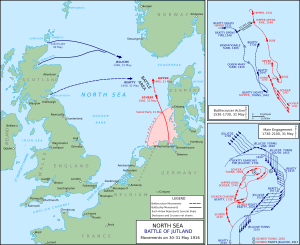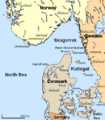Battle of Jutland facts for kids
Quick facts for kids Battle of Jutland |
|||||||
|---|---|---|---|---|---|---|---|
| Part of World War I | |||||||
|
The Battle of Jutland, 1916 |
|||||||
|
|||||||
| Belligerents | |||||||
| Commanders and leaders | |||||||
|
|
||||||
| Strength | |||||||
|
|
||||||
| Casualties and losses | |||||||
|
|
||||||
The Battle of Jutland was the most important naval battle in World War I.
In WWI, the German fleet was blockaded by the larger Royal Navy. For the most part, it was kept in its base at Wilhelmshaven. The Battle of Jutland happenened when the German fleet, lead by Admiral Reinhard Scheer, tried to break out into the open sea. The German fleet consisted of 22 battleships, five battlecruisers, 11 cruisers and 61 torpedo-boats. Scheer also had submarines with torpedos. These he arranged outside the main British bases.
The main British bases were in Scotland: the Orkney and Shetland had a huge base at Scapa Flow, and bases on the mainland were at Cromarty on the Moray Firth and at Rosyth on the north bank of the Firth of Forth.
So, the British fleet steamed south-east from their bases and met the German fleet steaming due north. The battle was fought over a wide area at Jutland Bank west of the Skagerrak between Norway and Denmark.
Contents
The code books
Scapa Flow is a long way from the Skagerrak, but as it was, the British fleet was forewarned of the German sortie. The British had cracked the German cipher, and when Scheer gave the order to sail, the Admiralty in London gave the Grand Fleet orders to sail from the Orkneys.
This was the result of the British getting hold of three code books from wrecked ships. One book for smaller vessels was from a German freighter. Another for diplomatic messages was got from a wreck on the bottom of the North Sea. The code for the German High Seas Fleet was from a cruiser wrecked in the Baltic. Though the British did not make the best use of these sources, they had in their hands a priceless advantage.
The course of the battle
The first skirmish
The first group of British ships to make contact were those from the Firth of Forth, commanded by Vice-Admiral David Beatty. Beatty had six battlecruisers, and four fast battleships. They got through the submarine cordon outside the Firth of Forth with no casualties.
Beatty's battlecruiser group met the German battlecruiser force led by Rear-Admiral Franz Hipper. The German advantage in range-finding (superior optics) was important, but the British cruisers were saved by the arrival of the four battleships. Since the battleships were superior in both armour and firepower, Hipper was forced to turn away towards the east and the main German force of battleships.
The main forces
Finally, late in the day. the main battlefleet (the 'Grand Fleet') from Scapa Flow (led by Admiral John Jellicoe) met the main German force of battleships (commanded by Admiral Scheer). "To Scheer's range-takers... the entire arc stretching from the north to the east was a sea of fire".p128 After ten minutes of this, Scheer signalled a simultaneous turn-away.
21 torpedos caused Jellico also to turn away, and Scheer put 10 miles between the British battleships and himself. As darkness grew, there were a few more encounters, until the German fleet made it home. They had sunk more British ships, but the balance of power had not changed.
Images for kids
-
Reinhard Scheer, German fleet commander
-
The throat of the Skagerrak, the strategic gateway to the Baltic and North Atlantic, waters off Jutland, Norway and Sweden
-
(1) 15:22 hrs, Hipper sights Beatty. (2) 15:48 hrs, First shots fired by Hipper's squadron. (3) 16:00 hrs-16:05 hrs, Indefatigable explodes, leaving two survivors. (4) 16:25 hrs, Queen Mary explodes, nine survive. (5) 16:45 hrs, Beatty's battlecruisers move out of range of Hipper. (6) 16:54 hrs, Evan-Thomas's battleships turn north behind Beatty.
-
(1) 18:00 Scouting forces rejoin their respective fleets. (2) 18:15 British fleet deploys into battle line (3) 18:30 German fleet under fire turns away (4) 19:00 German fleet turns back (5) 19:15 German fleet turns away for second time (6) 20:00 (7) 21:00 Nightfall: Jellicoe assumes night cruising formation
-
HMS Caroline, the last surviving warship that saw action at Jutland, is preserved in Belfast, Northern Ireland
See also
 In Spanish: Batalla de Jutlandia para niños
In Spanish: Batalla de Jutlandia para niños


















